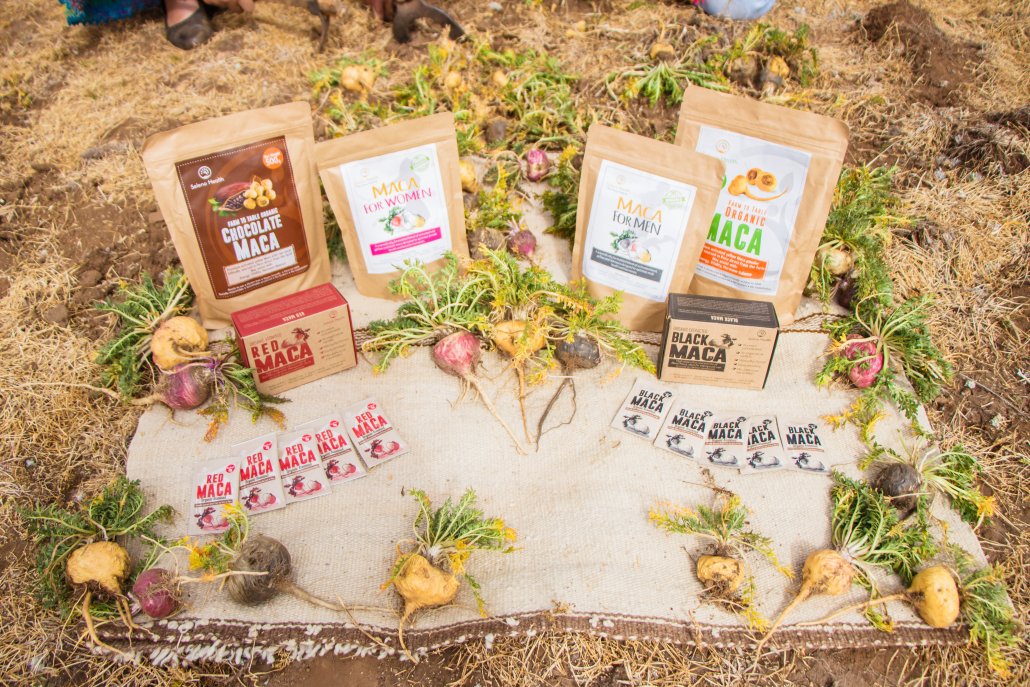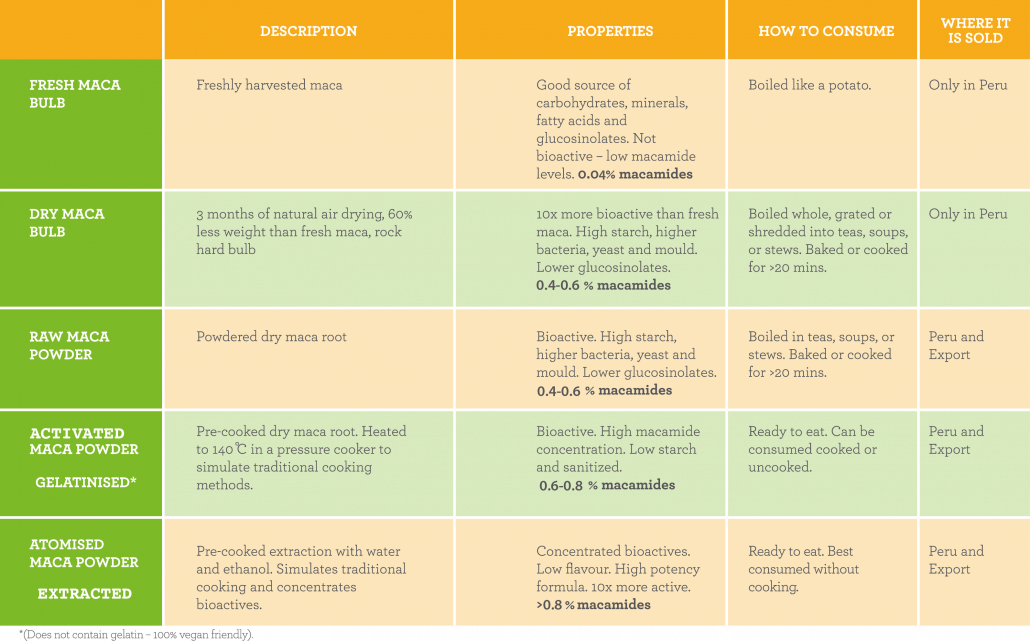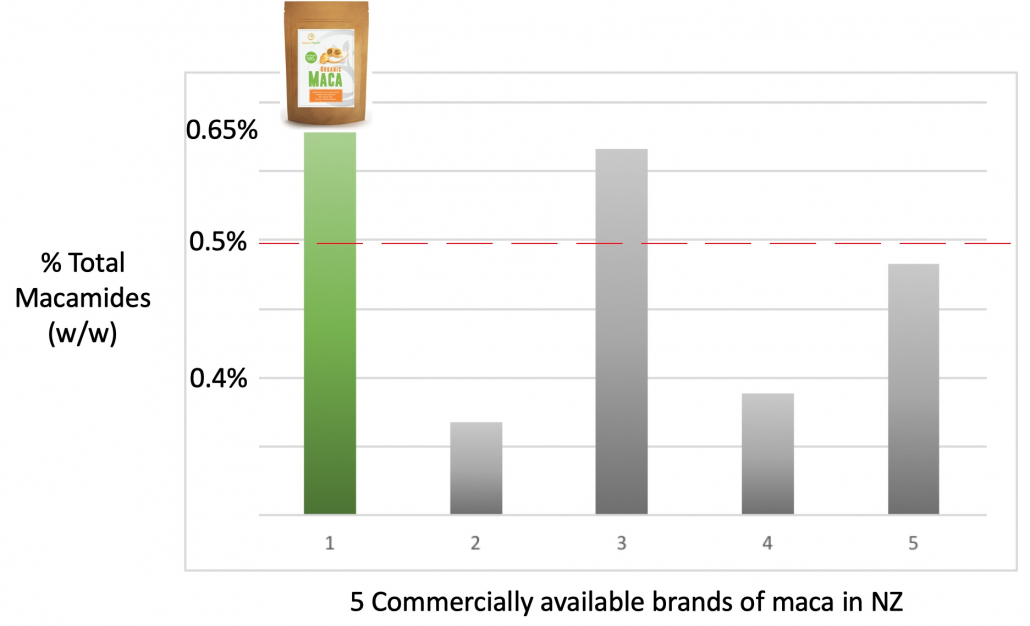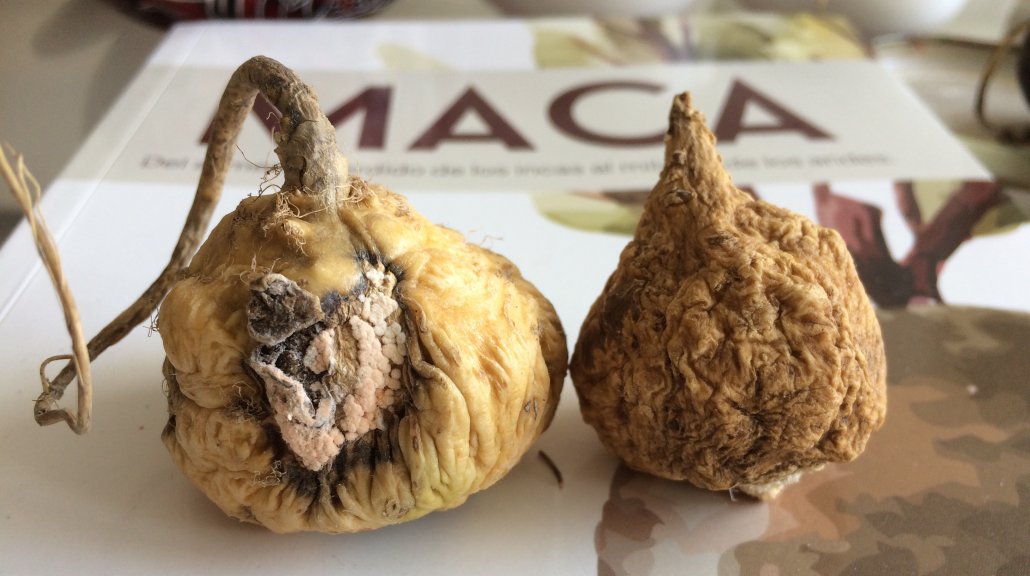What is the best maca powder to buy?
Making therapeutic grade Maca is a blend of tradition, art and science. There are so many variables that can influence the quality during production and in turn alter the taste, texture and therapeutic properties of the final powder. Couple this with the ethics and sustainability of how it is sourced and finding a quality powder that isn’t hurting a community or the environment can be like finding a needle in a haystack. How do we know whether or not the powder we buy is worth the cost we pay? What is the best maca to buy? And how do we know whether or not we are fuelling the exploitation of farmers and communities in Peru?
The first thing to know when choosing a good maca powder is what type of maca it is. The type of preparation of Maca will determine the way it should be prepared and in-turn the taste and therapeutic properties. Consuming Maca in the wrong way may greatly affect the potency and may even have negative side-effects on the body, not to mention an off-putting taste. Below is a chart outlining the different preparations and how each is best prepared in-line with science and tradition. One of the largest mistakes with regards to Westernised consumption of Maca is the ingestion of raw powder. This goes against the traditional practice of how it is consumed and the scientific studies relating to it. The best advice is to never eat raw maca due to the risk for mould and aflatoxins and also the nasty taste it has. A failure to dry and heat-treat maca can lead to mould and subsequent aflatoxin accumulation which can be toxic to the gut and liver, making your health worse. So even if you cook your raw powder it may already have aflatoxins, which are not destroyed by heat. For these reasons it is much safer to buy activated maca (pre-heated) and ensure you can fully trace its origin to the farm and the techniques used in its production. All our maca is activated, safe for the gut, tested for mould and aflatoxins and ready to eat.
For those looking for delicious ways that maca can be included in your daily routine check out our recipe booklet. Beside the type of maca you must also know what colour of maca you are consuming (yellow, red or black maca) as each has different biochemical profiles and offers different benefits. Matching the colours of maca to the constitution of the person can greatly improve the benefits they receive. Finally what are you trying to treat? As this will influence the type of maca chosen, the colours of maca used and way you consume it. The health benefits of maca powder are vast as are the list of treatable conditions with maca. So check what you are trying to treat and the best combination for that condition before selecting a maca powder.
The different types of maca and how each should be prepared.
The bio-active components of Maca that work in our brain to harmonize hormonal and nervous system imbalances are a series of Maca-specific fatty acid derivatives known as macamides and macaenes. These molecules work directly with a key enzyme in our endocannabinoid system (FAAH) to regulate and balance our entire endocrine function. They also act as key quality markers to the therapeutic potential of your Maca and a guide as to what dose you should take. A simple method to calculate the activity of a powder is to analyse the macamides and their respective weight per gram of powder. A good quality powder should have the macamide levels listed on the nutritional panel of the packet.
For a therapeutic powder a total known macamide weight percentage should be 0.6% or higher. This ensures 60+mg per 10g serve (1 tsp). The ideal target dose or maca for general conditions and maintenance should contain 60-100 mg of total macamides per day, while acute or chronic conditions can sometimes require 100-140 mg per day. It is best to consume daily for 6-12+ weeks to receive the optimum benefit for most endocrine issues. and follow our guide for taking maca.
An independent analysis of 5 commercially available samples in New Zealand recently demonstrated only 2/5 powders were within this therapeutic range, meaning many customers purchasing Maca may be wasting their money on inferior powders that lack any therapeutic benefit. This is because macamides are all made predominantly post-harvest, so the most important steps are after the root has been pulled from the ground. They require optimum selection, a minimum of 3 months of sun drying and then proper processing to become therapeutic. To ensure you are taking Maca that works check the macamide concentrations on the pack or with the supplier. Not all maca is equal, the best maca powders will have standardised macamide levels and every batch will be tested to ensure quality.
Not all maca powders are created equal. Macamide levels act as ideal quality guides for therapeutic benefit.
HPLC analysis of total macamides in randomly chosen commercial samples in New Zealand expressed as a % of total weight (mg/g).
Maca is a plant unique to the Andes of Peru. It only grows between 3800-4500m and has been cultivated by the Inca for over 2000 years for medicinal and therapeutic uses. The main farming area and spiritual home to Maca is in the region of Junin where climatic and soil conditions are ideal to produce the best quality roots. Scientific studies have shown that Maca grown in other areas of Peru and the world lack the therapeutic properties of Maca from its cultivated birthplace in Junin (see here). Recently Maca has been illegally taken from Peru and cultivated in China, creating issues as Chinese maca generally lacks the therapeutic potential of the Peruvian equivalent. Furthermore there is ongoing concern about GMO Maca from China due to their high number of patents for such crops. GMO was banned in Peru and as such all Peruvian maca is GMO free. All Maca sourced from Peru comes with a certificate of origin that should be provided upon exportation. Included should also be an organic certification as well as analysis of mould, yeast, bacteria, aflatoxins and heavy metals for safety.
Ensure you are getting Maca from Junin as this is the region that produces the best quality roots and ensure it is organic certified and free of any of the nasties that are high risk when consuming maca like aflatoxins. Also check if it is single origin (from 1 single farm) or multi origin (multiple farms) as this can affect the quality, single origin maca is always best. Multi origin maca is often an assortment of quality powders mixed with cheaper powders to create a blend. Authentic artisanal, sun-dried maca from a single origin is most likely going to be the most therapeutic and safest to consume and should contain the highest levels of macamides. So for your own safety make sure you can tick the boxes for the following information:
- Certificate of origin (Junin, Peru)
- Organic certification (USDA or EU)
- GMO free
- Safe levels of mould, yeast and bacteria
- Safe levels of aflatoxins
- Safe levels of heavy metals
- Single origin
Without knowing the source of your maca the risk for mould, aflatoxins, heavy metals, GMO is very high. Choose a single-origin, safe, certified and tested quality powder to protect you and your body.
Maca is the most sacred plant of Junin for the indigenous people who cultivate it. Cultivation of maca is as much spiritual as it is physical for the locals. All our maca is prepared with respect for Pachamama and in-line with all her sacred ancient traditions. We follow the practice of Pagapu – payment to Mother Earth in order to fill our nurturing soil with love and intention. In return Pachamama provides healing medicine for us all to consume. The spiritual practices surrounding the planting and harvesting of maca are as important as the techniques used as the spirit of maca is what heals our bodies. We believe if we are lucky enough to have access to these ancient plant medicines then we should all treat them with the respect they deserve. Not all Maca is equal and not all companies comply with these sacred requirements.
We practice cultural respect by following the spiritual process of Pagapu – payment to Mother Earth to ensure our maca is full of healing medicine.
Beyond this, Incan tradition allows for 10 years of soil resting and re-mineralising after harvest before re-planting. This is their respect for Pachamama (Mother Earth) and how they protect their local environment. The farmers see this as a 10-year soil preparation cycle for Pachamama during which times crops are rotated. Following this logic every batch of our maca takes 13.5 years to produce from start to finish – 10 years of soil preparation, 2 years for production of the seeds, 1 year to grow and harvest the medicinal root, 3 months to naturally sun-dry and 3 months to powder, heat-activate, package and ship. By respecting their culture and traditions we are also creating a sustainable way to produce Maca that preserves the environment and their culture.
Many farmers in the region of Junin are lucky to receive $1-2 per kg for their Maca, while companies around the world sell the same powder for up to $120 per kg!! Farmers often talk about pricing wars where brokers demand impossible prices, while threatening to buy from other sources if the price is not met. Most Maca farmers are living far below the poverty line without access to basic essential living necessities and comforts. They often will sell for incredibly low prices just to receive money up front to feed their families, then find that they have no more income until their next batch of Maca is produced a year later. A large amount of Maca sold for export is from stockpiles accumulated via this practice and is the reason for the economic, cultural and spiritual demise of the Maca farming industry. Without fair reward farming communities are stuck far below the poverty line with catastrophic social decline due to continual economic pressures.
Farmers in these communities push their Maca production at the expense of the environment, leaving long-lasting damage to land that may take generations to fix. As farmers struggle to manage the issues with supply and demand many farms are now on the brink of an environmental disaster. Without a change to a sustainable approach to farming we could see less and less land being suitable to grow Maca over the next 10 years. From a spiritual perspective this economic and environmental exploitation has turned a 2000-year-old sacred practice into a commercialised venture where traditions are being rapidly lost. The demand from brokers and exporters in a hurry to get rich off the backs of farmers has taken the spirituality away from the communities that cultivate Maca and replaced it with empty promises.Beyond this is the company selling it being socially responsible and giving back to the community?
We believe it is up to us as consumers, suppliers and retailers to protect the heritage, culture and history behind maca and to create an ethical and sustainable way to produce it that benefits all involved. We have a direct partnership with our farm, farmer and community and are committed to offer protection from exploitation. We buy direct from our farmer with a transparent pricing structure so he can see the value of his product in our market.
We allow full production of our final product to be carried out by our farmer in Peru, so in essence we are selling his product on his behalf and sharing back profits with him. We donate a further percentage of our profits back into a development fund to improve the lives of the people who produce our products. So every bag sold equates to approximately $1 towards supporting our community.
Currently we are improving the conditions at the San Jose de Quero school and our farmer’s house, in terms of infrastructure, consumables, heating, water, internet and sanitation. We sponsor 14 different children from the community and pay for their annual schooling needs. We have already funded the building of accommodations to house eco-tourists that will allow a long-term sustainable income for our farmer and family additional to his current trade. We are also creating cultural and profession development programs for our farmer, his family and the local school children to improve their levels of education and professional experience. Learn more about our social responsibility here.




